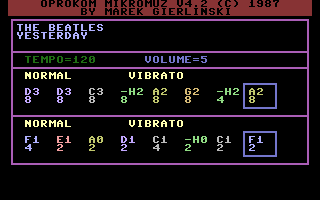|  Oprokom Mikromuz V4.2 Oprokom Mikromuz V4.2 | | Title: | Oprokom Mikromuz V4.2 | | Category: | Utility/Music | | Release Date: | 1987 | | Language: | English/Polish | | Size: | 16K | | Machine: | PAL & NTSC | | Code Type: | Basic + Machine code | | Distribution: | Freeware | | Notes: | Written by (private). A competent music editing system. |
Download:
Marsz Turecki:
The Beatles Yesterday:
No votes yet.
|  |
|
| |
|  Instructions Instructions | Created based on Polish instruction included on D64 (auto translated and slightly extended)
Instructions from Marek Gierliński:
This is a music program that allows the playback of music notes on computer.
The program allows you to simultaneously use both sound channels, generating no noise, add vibration or sound modulation.
To perform some piece of music you must first enter into the computer's memory a special player program.
The extension of the code from the PLAY statement have similar syntax and commands as BASIC language from MICROSOFT on IBM computers (MS-BASIC and GW-BASIC)
https://www.vgmpf.com/Wiki/index.php?title=Microsoft_BASIC_MML
After loading the main resident program and running it with SYS4112, we enter the music code using the standard BASIC editor.
It can be preceded by any program BASIC. A signal the beginning of the music code for Mikromuz resident program is the string 'OKMM' placed on a line directly preceding the code itself.
This means that after starting the main player program it looks for a string in the BASIC area 'OKMM' and starts code execution from the next line onwards.
First two lines after the delimiter are not executed, but only transferred for the screen - they are intended for title. Note: Due to the fact that keywords appearing in the text are replaced by the editor with special ones characters must precede each line of code REM, DATA instruction or quotation marks.
This will prevent this undesirable occurrence phenomenon; first symbol in the line (i.e. REM) is provided by Mikromuz ignored. This also applies to the title.
The actual code starts with three line after the limiter. It consists made of two parts, each ending with an asterisk. These are records for both channels. Recording for any channel can be empty.
Syntax:
The record may consist of the following characters:
CDEFGAH - note names
+ or # - hash: half a tone higher
- - flat: half a tone lower
. - dot: lengthens the one following it note about half; may be multiple times
P - pause
Tn - tempo: n indicates how many quarter notes fits in a minute; n=4..460
Ln - sound length: n specifies how long times a given note fits into a whole note, up to 64. Eg.:
L4 quarter note, default value
L1 whole note
L12 element eigth note triplet
On - octave; n=0..5
Note: they only appear in the zero octave notes: A -H H
Vn - volume; n=0..8
Ba/o - vibrato: a means amplitude, (1..255), o - oscillation period (4..63999)
B0 - vibrato off
MN - 'normal' music: every note is sounded for 7/8 of its time duration, the remaining 1/8 is filled with silence
ML - legato music: the note is sounded until the end
MS - staccato music: the sound occupies 3/4 of the duration of the note
MP - spizzato music: the sound occupies 1/2 the duration of the note
Rn - beginning of the loop: fragment of the recording starting from here until the X mark
will be repeated n times; n=1..255
X - end of loop
Sn - equivalent of the BASIC instruction
SOUND: produces a sound with a height n; n=0..1022
N - turns it on or off noise of the second generator
Qw/n/o - vibration: cyclical changes sound volume with parameters:
n - build-up
w - sound
o - falling
all three parameters take values from 0 to 255, where:
Q0 - vibration switching off
$x - additional options, where x can be:
Gn - jump to line n: natural change code execution order (only for given channel)
B - start code execution from the beginning (for both channels!)
C - comment: following it the line is ignored
In - conditional execution: matters inside the loop; the entire record starting from of this character to the end of the line will be only during the nth repetition loops
SPACE - is a separating character and is ignored by the program
---------------------------------------------------------
Immediately after starting the program, parameters music are set to the following, initial values:
T120 L4 O2 V8 B0 Q0 MN
Active while the program is running the following keys are:
+,- increase and decrease pace
ESC - temporary suspension of the program until you press the S key
S - restart the program
STOP - interruption of the program
---------------------------------------------------
We run the program with the SYS4112 instruction.
It is most convenient to place it at the beginning of the program (before the limiter) and start the Micromuz with the RUN instruction.
---------------------------------------------------
Example:
0 sys 4112
10 okmm
20 "the beatles
25 "yesterday
1000 rem t120
1010 rem v5 o2 l8 r16
1015 rem $i2 v4
1016 rem $i9 v5
1017 rem $i10 v4
1019 rem c x v5
1020 rem b4/130 r2
1025 rem $i2 v7
|
| |
Copyright © Plus/4 World Team, 2001-2025. Support Plus/4 World on Patreon |